

Blog
After years of inspecting multifamily housing developments across the country for compliance with regulatory requirements for accessible design and construction, our accessibility team has compiled a list of common violations that could easily have been avoided before construction even began.

By addressing requirements for accessibility in the early phases of a project, designers can preempt the need for costly remediation during construction and greatly reduce the possibility of potential litigation.
Here are just a few examples of common violations that we come across in public and common-use areas in multifamily buildings on a regular basis. Look out for part two covering common violations in residential units.
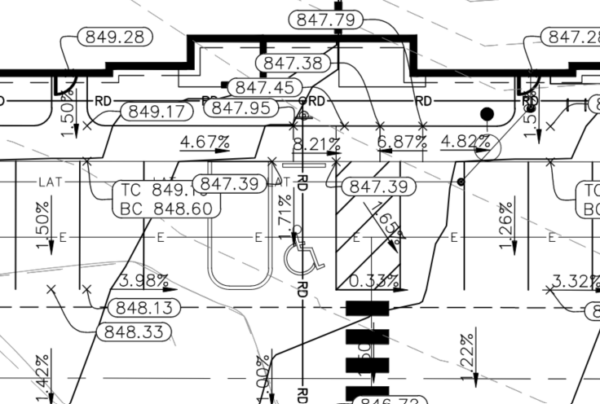
At least one accessible route is required to connect site arrival points, accessible building entrances, various site and building amenities, and dwelling units in the project. All too often, we arrive on site to find that the slopes of these accessible routes are not compliant, necessitating the ripping up of sidewalks and flooring materials – an undertaking that can quickly become expensive.
When considering an accessible route, there are two important slopes to keep in mind: cross slope and running slope.
By identifying the required accessible routes on the drawings and providing notes and slope indicators along these routes rather than spot elevations, it is possible to greatly increase the chances of compliance once the concrete is poured and the building is constructed.
Where possible, slopes should not be designed to the maximum permitted, allowing for tolerance in the field.
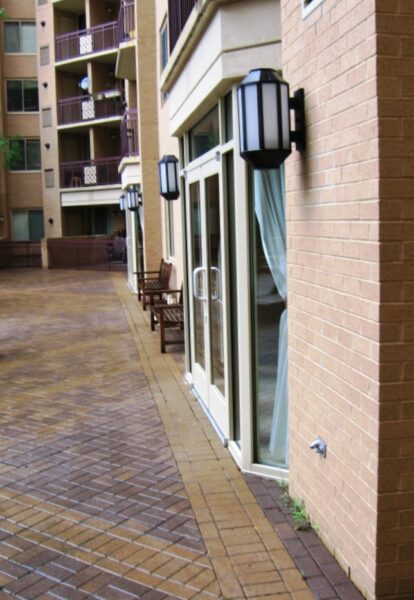
Accessible design isn’t just about ensuring access for those with mobility impairments. Another important and often missed requirement applies to those who are blind or have low vision.
A protruding object can be something as basic as a wall sconce, bar countertop, or drinking fountain and as seemingly innocuous as a piece of artwork on the wall. Any element that is located 27-80 inches AFF and projects more than 4 inches from a wall can prove hazardous to someone who does not have the ability to see it. The projecting objects themselves may seem small, but the cost of replacing hundreds of lighting fixtures throughout a building can be astronomical.
While the best method of avoiding protruding objects is to specify wall-mounted sconces and other fixtures with a low profile, there will of course be situations that require other solutions.
Where a protruding object exists, one solution to reduce the potentially hazardous condition is to install a cane-detectable barrier below it to ensure that a person with a visual impairment will be able to identify and avoid the object. This can be as simple as positioning a planter or built-in piece of furniture below a wall sconce or piece of artwork or installing a foot rail or knee wall below projecting bar countertops. Locating drinking fountains within alcoves is another method of achieving compliance.
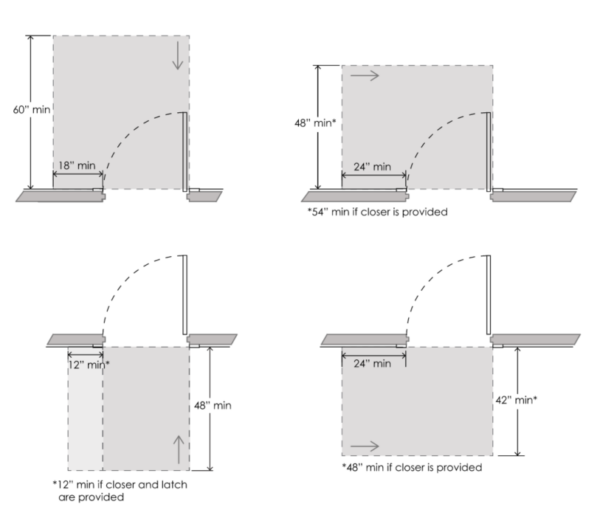
All doors along the accessible route must provide compliant maneuvering clearance on both sides of the door. Clearance required beyond the latch and perpendicular to a door depends on the approach. At doors equipped with closers, additional clearance is required for certain approaches.
It is important to coordinate with finished materials, furnishings, etc. to ensure that all clearances will be met when construction is completed. Often, plans are missing the critical latch side and perpendicular dimensions and inconsistencies in construction will result in noncompliant clearance when all finishes are installed. Designers should include these minimum required dimensions in design and be sure to review any changes during construction (e.g., different wall finishes, addition of a closer, etc.) that could impact compliance.
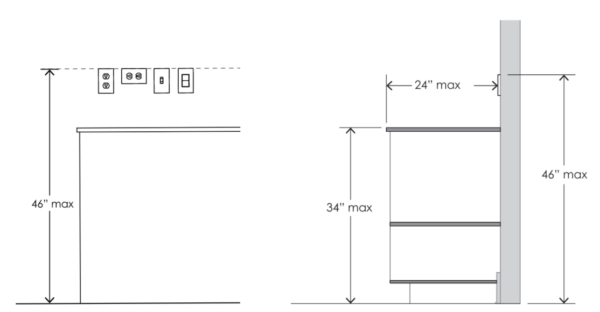
Outlets and controls in common areas that are intended to be operated by residents and their guests must be accessible. Outlets, switches, and other controls located over counters are often missed by designers, resulting in noncompliance identified during construction.
In many projects, interior designers are responsible for the millwork that will be installed in amenity spaces, leading to gaps in coordination with the electrical plans.
Where outlets or other controls are mounted over countertops, the counter must be no more than 34 inches in height and the reach depth to the control must be no more than 24 inches. Building out backsplashes to place outlets within reach range is a possible method of achieving compliance when standard depth counters are used.
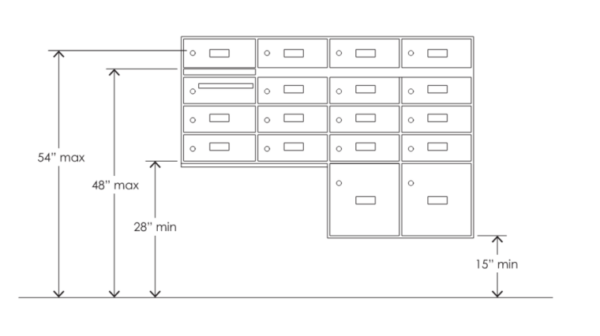
Depending on the applicable building code and the chosen HUD-approved safe harbor for FHA compliance, up to 100% of mailboxes serving covered dwelling units are required to be mounted within accessible reach range.
In the event of a complaint, HUD will identify violations of the Act by demonstrating noncompliance with the Fair Housing Accessibility Guidelines. This means that any mailboxes mounted higher than 54 inches AFF to the centerline of the highest tenant lock will be flagged as noncompliant.
It is important for designers to understand the applicable requirements of their chosen safe harbor, comply with that safe harbor in its entirety, and be ready to demonstrate compliance with the requirements of that chosen safe harbor should questions arise in the future.
To meet FHA requirements, our consultants recommend mounting all mailboxes serving covered dwelling units no more than 54 inches AFF to comply with the FHA Guidelines, regardless of the chosen safe harbor as this will eliminate any need to demonstrate compliance down the road. However, always check requirements of the applicable building code, which may be more stringent than what the FHA Guidelines require.
By addressing these common violations in the design phase of a project, it is possible to greatly reduce the need for change orders and costly delays once construction begins. A little planning ahead can save a lot of time and money in the long run.
SWA’s accessibility team has longstanding knowledge of the accessibility requirements that apply to all types of buildings and facilities in locations across the U.S. Contact us to get started on a project.
Steven Winter Associates